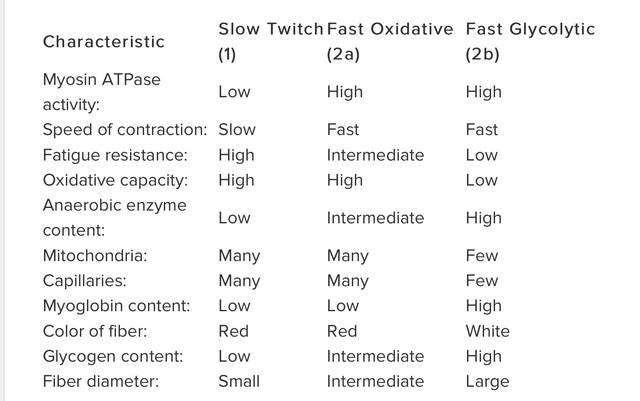Jenny TipsforME
Senior Member
- Messages
- 1,184
- Location
- Bristol
A slightly random thought about mitochondrial stuff:
In my 23andme info it talks about me potentially being a sprinter. My first reaction was obviously yes right! But this is to do with fast twitch fibres in how the muscle is made up proportionally. So I have proportionately more fast twitch fibres
yes right! But this is to do with fast twitch fibres in how the muscle is made up proportionally. So I have proportionately more fast twitch fibres
"which are lighter in coloring than slow-twitch fibers due to the low levels of myoglobin (the iron-containing protein found in muscle cells that stores oxygen for use in cell respiration) and mitochondria they possess...
The fast-twitch fibers, however, were re-classified due to observed differences in their properties. Fast-twitch fibers now have two subcategories: Fast-Glycolytic (FG) or Fast-Oxidative-Glycolytic (FOG), or 2b and 2a fibers respectively. FG fibers differ from FOG fibers in their pure fast-twitch properties.
They have few mitochondria and high levels of stored glycogen and the enzymes necessary for producing energy without oxygen. The FOG fibers have the stored glycogen and enzymatic properties of FG fibers, in addition to high levels of oxidative enzymes which assist aerobic metabolism. They have the best of both worlds."
https://www.bodybuilding.com/fun/drobson33.htm (I don't know which type I have more of)
This seems like it might go more wrong, if you also have a tendency to mitochondrial disease or dysfunction?! Eg The hallmark of slow twitch fibres is fatigue resistance, so I'm just speculating that having fewer than average of these may not be serving me well in my current circumstances.

Has anyone looked into this? Eg @JaimeS or @Valentijn have you thought about this?
In my 23andme info it talks about me potentially being a sprinter. My first reaction was obviously
"which are lighter in coloring than slow-twitch fibers due to the low levels of myoglobin (the iron-containing protein found in muscle cells that stores oxygen for use in cell respiration) and mitochondria they possess...
The fast-twitch fibers, however, were re-classified due to observed differences in their properties. Fast-twitch fibers now have two subcategories: Fast-Glycolytic (FG) or Fast-Oxidative-Glycolytic (FOG), or 2b and 2a fibers respectively. FG fibers differ from FOG fibers in their pure fast-twitch properties.
They have few mitochondria and high levels of stored glycogen and the enzymes necessary for producing energy without oxygen. The FOG fibers have the stored glycogen and enzymatic properties of FG fibers, in addition to high levels of oxidative enzymes which assist aerobic metabolism. They have the best of both worlds."
https://www.bodybuilding.com/fun/drobson33.htm (I don't know which type I have more of)
This seems like it might go more wrong, if you also have a tendency to mitochondrial disease or dysfunction?! Eg The hallmark of slow twitch fibres is fatigue resistance, so I'm just speculating that having fewer than average of these may not be serving me well in my current circumstances.

Has anyone looked into this? Eg @JaimeS or @Valentijn have you thought about this?
